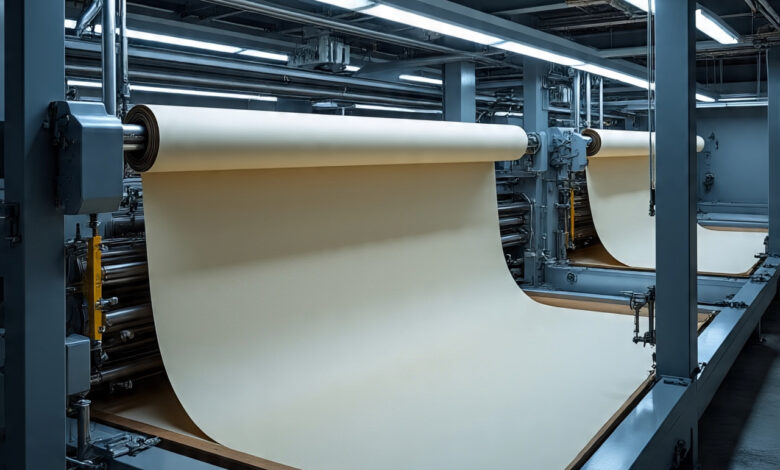Weaving Efficiency into Every Sheet: The Rise of Paper Machine Clothing

Behind every sheet of packaging paper, tissue, or fine paper lies an intricate support system few ever see—but paper makers couldn’t function without. It’s called Paper Machine Clothing (PMC), and it forms the backbone of the papermaking process.
From forming to drying, PMC acts as the silent engine driving quality, speed, and efficiency. And in a world pushing for more sustainable packaging and high-speed production, this segment is spinning into a high-growth phase.
According to Stratview Research, the Paper Machine Clothing Market is expected to reach US$1854 million by 2030, growing at a CAGR of over 1.8% during 2024–2030.
The Problem: High-Speed Machines, Higher Expectations
Paper machines today are engineering marvels—some stretch over 100 meters long and operate at speeds exceeding 2,000 meters per minute. But even these giants are only as good as the fabric that supports them.
Without high-quality PMC, paper production can suffer from:
- Inconsistent sheet formation
- Poor dewatering and drying efficiency
- Reduced machine speed and uptime
- Frequent replacements and high maintenance costs
As mills push for higher throughput and lower energy consumption, the role of precision-engineered clothing has become more important than ever.
Agitation: The Cost of Getting It Wrong
In modern paper mills, even a minor defect in PMC can lead to:
- Production losses worth thousands of dollars per hour
- Reduced paper quality, leading to waste and customer complaints
- Higher energy costs, especially in inefficient water removal stages
- Increased downtime due to premature fabric wear or improper installation
Given today’s razor-thin operating margins, any inefficiency in clothing performance translates to direct financial losses.
Solution: High-Performance PMC for High-Performance Mills
PMC consists primarily of forming fabrics, press felts, and dryer fabrics, each tailored to a specific section of the paper machine:
- Forming Fabrics
- Provide fiber support and water drainage during sheet formation
- Designed for optimal fiber retention and sheet uniformity
- Press Felts
- Used in the press section to remove water from the sheet via pressure
- Engineered for high nip dewatering and long service life
- Dryer Fabrics
- Transport and dry the sheet with controlled tension and heat exposure
- Ensure wrinkle-free sheet handling and consistent drying rates
Today’s advanced PMC solutions use multi-layer weaves, monofilament yarns, and thermoplastic composites to achieve unmatched strength, permeability, and dimensional stability.
Stratview Insights: What’s Driving the Market
The growth in PMC demand is closely tied to:
- Rising global demand for packaging paper, driven by e-commerce, retail, and sustainability initiatives
- Technological advancements in paper machines, especially in Asia-Pacific
- Shift toward specialty paper and tissue, requiring highly customized clothing designs
- Increased focus on energy savings, water conservation, and process optimization in paper mills
Stratview Research notes that forming fabrics remain the largest product category, but dryer fabrics are growing faster due to rising energy efficiency goals.
Regional Outlook: Asia-Pacific Leads the Charge
- Asia-Pacific dominates the market, accounting for over 45% of global demand, with China and India investing heavily in new paper machines and recycled packaging lines.
- Europe emphasizes sustainability and efficiency upgrades, driving demand for high-end PMC solutions.
- North America is showing steady growth, with investments in tissue and containerboard production in response to evolving packaging regulations.
Key Players in the Paper Machine Clothing Market
Stratview Research identifies several global leaders and innovators:
- Albany International Corp. (USA) – One of the largest PMC providers, offering advanced multi-layer forming and drying fabrics with global service capabilities.
- ANDRITZ AG (Austria) – Known for its engineered press felts and PMC used in high-speed machines and specialty paper production.
- AstenJohnson (USA) – A specialist in woven and nonwoven fabrics for forming, pressing, and drying sections, with a strong footprint in North America and Asia.
- Valmet Oyj (Finland) – Integrates PMC with its papermaking systems, offering tailored solutions and predictive maintenance support.
- Heimbach Group (Germany) – A major supplier of press felts and dryer fabrics, especially for tissue and specialty grades.
- Voith Group (Germany) – Offers both PMC and complete paper machine solutions, leveraging digital tools for condition monitoring and fabric optimization.
- Xerium Technologies (USA, now part of Andritz) – Focused on value-added PMC for both new machines and aftermarket replacements.
Strategic Takeaways
- PMC is no longer just a consumable—it’s a performance driver.
- Mills are shifting from generic fabrics to application-specific, data-optimized PMC solutions.
- Service, training, and digital monitoring are becoming as important as the fabric itself.
- Suppliers that provide end-to-end solutions—from design and installation to performance tracking—are gaining a competitive advantage.
Looking Ahead: Woven for Sustainability and Speed
As the paper industry retools for a world without plastic and with rising demand for recyclable packaging, PMC will remain central to achieving production efficiency, quality, and energy goals.
Stratview’s Paper Machine Clothing Market Report offers in-depth segmentation by product type, machine type, paper grade, region, and application—helping manufacturers, suppliers, and investors navigate this essential and quietly high-tech segment.
Stratview Research
E-mail: sales@stratviewresearch.com
Direct: +1-313-307-4176



